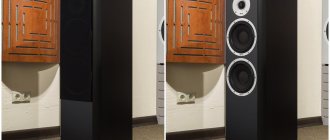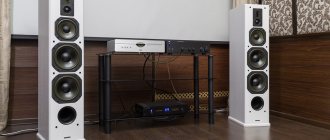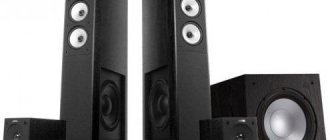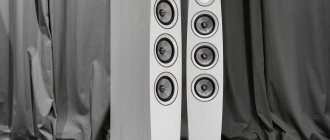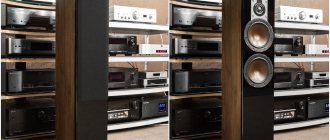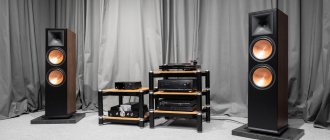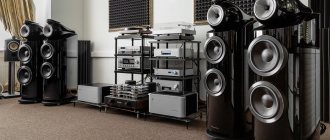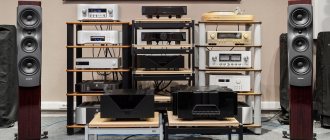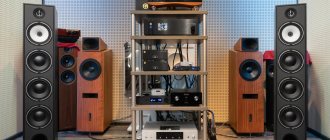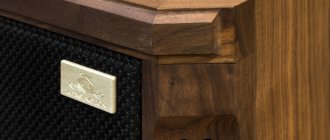Not everyone can and wants to spend a lot of money on buying Hi-Fi speakers. Everyone determines a reasonable limit for themselves, but especially so that we, buyers, can easily navigate the assortment, marketers divide products into classes. Here are budget models with a “basic” set of technologies, and here are the top Hi-Fi and High End models, where all the best is implemented. Well, the middle class is for those who accept compromises. It would seem that everything is logical and convenient, but then Dynavoice appears and breaks the pattern completely.
In the Dynavoice model range, the Definition line is the oldest, as a result of which it has every moral right to be exorbitantly expensive, because it is in this line that the manufacturer demonstrates all its engineering and technical potential. However, after reading the price tag of the pre-top floor-standing model DF-6, I was surprised to find that in financial terms (price - 65,500 rubles) it easily competes with mid-budget models of most well-known brands.
Narrow and tall floorstands fit easily into a small room
If we talk about design and technology, the speakers look more than grown-up. Well, not every manufacturer can boast of a four-way design and the presence of a ribbon tweeter, even in significantly less affordable models.
Super task
Assembling a system for a small room is not difficult. You don't need a powerful amplifier or large speakers. You can find high-quality bookshelf speakers even in a relatively budget segment, and choosing a suitable amplifier is not difficult. Things are much more complicated in a situation where you need to sound a large space.
Big sound can only be achieved with big speakers
Floor-standing acoustics, in principle, are more expensive, more complex in design and much more capricious in terms of matching with the acoustics of the room. Plus, it will take a long time to select an amplifier, because a lack of power or a small damping factor can make even the best acoustics boring and uninteresting. Well, if you like to make it louder, then either get ready for compromises, or put up with a serious increase in the budget of the future system. Exceptions are, of course, possible, but searching for them is akin to treasure hunting. The salon specialists offered me a solution to the problem using the AMC XIA100EP integrated amplifier and large Dynavoice DF-8 floorstanding speakers.
Still in service
The letters AMC today are more associated with the TV channel of the same name, which released many popular TV series, but among audiophiles of the 90s these three letters were also associated with inexpensive but high-quality amplifiers. Today, a significant part of the AMC product range consists of installation components used in Smart Home systems and installed in a rack. However, if you wish, you can find in the product list quite classic models designed for Hi-Fi stands. And the AMC XIA100EP integrated amplifier falls into this category.
The design of the AMC amplifier is quite traditional, it has remained virtually unchanged for the past twenty years.
This model has a power of 100 W per channel and operates in class AB. The circuitry is transistor, discrete, large aluminum radiators are hidden inside the case. The power supply includes a large toroidal transformer and a decent-sized capacitor unit. At peak load, the amplifier is capable of delivering up to 30 Amps, which allows it to cope with complex loads.
The design is simple and effective, just like professional installation technology
Optionally, you can supply a MM/MS phono stage or a DAC with a resolution of 24 bit/192 kHz, which will replace one of the six analog inputs. I note that the optional DAC is equipped with USB, coaxial and optical interfaces, and even has Bluetooth. Switching of the built-in pre-amplifier and power amplifier occurs externally using jumpers that connect the central contacts of the RCA connectors. If we remove the jumpers, we get a separate power amplifier input and pre-amplifier output. Thus, the AMC XIA100EP is perfectly suited for future upgrades. You can add a higher-quality pre-amplifier to the system, or, conversely, start improvements by replacing the power amplifier, postponing replacing the pre-amplifier until later.
Phono stage and USB DAC available as options
On the façade of the amplifier there are knobs for a classic switchable tone control that regulates high and low frequencies at 100 and 10,000 Hz. The manufacturer focuses special attention on the high quality of its work (audiophile components are used), as a result of which it has minimal negative impact on the sound. The difference in sound with the tone block turned to “zeros” and the “direct” mode is really barely noticeable to the ear.
The amplifier's remote control is modest, you wouldn't immediately think that it belongs to a Hi-Fi component
The adjustment knobs on the amplifier have a plastic facade, and their side surface, which the user touches, has a soft rubber coating. The input selector is implemented in an extremely unusual way. When rotated by hand, it has no fixed positions, and when controlled from the remote control, it slowly turns to the corresponding mark. The remote control itself looks modest, even somehow too modest.
Quadral Argentum 530
We have been familiar with the products of this German company for a long time - they look impeccable and invariably receive high marks for their sound. Let me remind you that the company’s headquarters is located in Hannover, where all acoustics are designed.
Argentum 530 are classic three-way monitors and the largest in our group. However, the price difference between them is not that significant.
The 18-cm low-frequency driver in a bass-reflex design begins to reproduce bass from 40 Hz, and the upper limit of the inch silk dome tweeter is extended to 35 kHz. In this era of high-resolution audio, this entry into the ultrasonic field can be considered a significant advantage. Please note that an acoustic lens is installed in the center of the dome between the protective brackets, leveling the frequency response across the entire width of the radiation pattern.
The middle band, set within the range of 350 - 2700 Hz, is reproduced by a 13.5-centimeter head. Its diffuser, like that of the woofer, is made of titanium-coated polypropylene - this structure has an optimal combination of low mass, rigidity and internal damping. Both drivers have wide elastic suspensions that can provide large displacements of the moving system.
Argentum 530 is available in black and white piano lacquer, the quality of the finish is traditionally very high. The grills are mounted on pins. The monitors are quite heavy – more than 10 kg each.
This is where it is appropriate to remember the saying “size matters.” In a room up to 35 meters in area, these monitors can easily replace floor-standing systems. 18-centimeter drivers (which are 7 inches, by the way) literally shoot through space, producing some kind of unrealistic bass depth. At the same time, it does not dominate the overall tonal balance; I would say that in the Argentum 530 the emphasis is on the midrange. It is very beautiful thanks to the richness of timbres and the ability to show all the characteristic features of the performers' voices. Acoustic guitar, wind and percussion instruments - everything is conveyed vividly and naturally.
The lower range is no less interesting. The bass may not be as fast as small paper drivers, but it is solid and detailed, with plenty of nuance. Double bass, bass drum, synthesized notes that vibrate glass - all this comes out easily, sounds free and with a full harmonic spectrum.
The dynamic potential is also impressive; with good gain, the Argentum 530 can please even the most demanding listener. The drum beat is a real test for the ears and sensations for the whole body.
The upper range is also good, it contains air, a cloud of upper harmonics when cymbals sound, and sharp localization of virtual sources throughout the entire frequency band. Accordingly, the stage is constructed with filigree precision - instruments, performers and artificially created effects are distributed on a grand scale across the foreground, and in good recordings one can also feel the perspective in depth.
It is better to listen to these bookshelf speakers from four to five meters, then the sound will be solid, evenly saturated across the entire spectrum.
Quadral Argentum 530
Manufacturer: Quadral GmbH & Co. KG (Germany)
audiotechnics.ru
Configuration: 3 emitters, 3 bands || Acoustic design: bass reflex || Frequency range: 40 - 35,000 Hz || Sensitivity: 87 dB || Nominal Resistance: 4 Ohms || Crossover frequencies: 350/2700 Hz || Power input continuous/peak: 80/120 W || Bi-wiring: no || Finish: black or white lacquer || Dimensions: 212 x 490 x 280 mm || Weight 1 piece: 10.6 kg || Price per pair: 52 930
rub.
Big and white
The acoustics are quite large and massive. Its front and back walls are covered with white varnish, and the sides and top are covered with white vinyl with a wood-like texture. The midrange and bass speakers have Kevlar diffusers, an elastic polymer suspension and a powerful cast basket. And the main decoration is the HF module with a fabric dome with a diameter of 2 inches and a ribbon emitter operating from 12800 Hz.
The look with a grill, in my opinion, is more elegant and stylish
The body contains two bass reflex ports of large diameter and considerable depth. It is curious that one of them is displayed on the facade at the bottom, and the other is on the rear wall at the top of the building. The set includes one pair of plugs, with which you can adjust the character of the bass sound in accordance with the acoustic response of the room.
A jumper in the crossover allows you to control the output of mid and high frequencies
In addition, do not forget about the proprietary adjustable crossover, which is equipped with many Dynavoice models. It makes it easy to boost or cut the treble and upper mid ranges. The jumper sets the modes -2, 0, +2 or +4 dB. In an acoustically prepared listening room, the jumper took the 0 dB position, but the plugs for the bass reflexes were not superfluous, since the room was relatively small, and hum periodically arose at the lowest frequencies.
Dynavoice Classic CL-16
When company founder Tommy Wadensten began creating loudspeaker systems in his basement in Falkenberg in 1975, he formulated his task as follows: loudspeaker systems should satisfy the sound not only of ordinary music lovers, but also of experts with extensive listening experience. Perhaps this is why products under the JWS and Dynavoice brands have regularly received awards from leading European audio publications for many years.
The Classic series was conceived as being as close as possible to the best examples of acoustics from the golden age of audio, both in design and in sound character. There are no ribbon tweeters or Kevlar diffusers here - everything is within the framework of classic hi-fi traditions. Particular attention is paid not only to linear tonal balance and high sound resolution, but also to the formation of a sound stage with the correct placement of instruments and voices.
Classic CL-16 bookshelf monitors feature a traditional two-way design with a crossover frequency of 2500 Hz. The lower range is voiced by a driver with a 6.5-inch impregnated cellulose cone. The wide elastic suspension is designed for large displacements of the moving system. With the support of a bass reflex with a rear port, the woofer begins to work effectively from 50 Hz - for such a volume of the case the declared value is quite realistic.
An inch tweeter with a silk dome is mounted on a wide flange, which serves as a vibration absorber. The upper operating limit is also traditionally hi-fi – 20,000 Hz. Despite the extremely simple design, the monitors allow bi-wiring connections.
The cases with a laconic nostalgic design are finished with the texture of wood veneer - black oak and walnut. The set includes two pairs of grills made of rough fabric of different colors in a classic Scandinavian style.
Having just listened to the Definition DM-6, the character of these monitors at first seemed somewhat colorless, but after a few tracks you understand that such neutrality is an extremely attractive charm. When you listen to the Classic CL-16, you somehow forget to focus on the sound, your attention automatically switches to the music. It seems as if they are playing speakers from the 70s with a perfectly adjusted tonal balance and powerful energy, evenly distributed throughout the entire operating range. There is no doubt that the developers achieved this effect on purpose, and the above-mentioned neutrality is a consequence of a careful balance of all objective and subjective parameters. And it’s impossible to find fault with any of them.
The CL-16 has impressive, well-structured bass, and is fast enough to handle complex rhythmic patterns. On the Yello recording, the monitors literally shoot out low notes - sharply and effectively. The overall dynamics also do not raise any questions: if you turn up the volume, the monitors can give a head start to small floor-standing systems.
The middle is rich in details, but the detail here is comfortable - if you wish, you can hear all the nuances, but they are not deliberately protruded. Female and male vocals, acoustic instruments and percussion are conveyed very naturally.
The only thing that may raise questions, especially in a dim room, is the not too bright upper range. Although cymbals, upper overtones of strings and airy reverberations are reproduced quite adequately.
The story with the stage is interesting: on most tracks it seems to exist by itself, the monitors seem to disappear from the sound field. This rare quality manifests itself even if they are not directed to the listening point.
Dynavoice Classic CL-16
Manufacturer: Dynavoice AB (Sweden)
cinemascop.ru
Configuration: 2 emitters, 2 bands || Acoustic design: bass reflex || Frequency range: 50 - 20,000 Hz || Sensitivity: 86 dB || Nominal Resistance: 4 Ohms || Crossover frequency: 2500 Hz || Recommended amplifier power: 25 – 120 W RMS || Power input continuous/peak: 75/120 W || Bi-wiring: yes || Finish: black, walnut || Dimensions: 220 x 380 x 300 mm || Weight 1 piece: 8.1 kg || Price per pair: 48 160
rub.
Strong and dexterous
The Dynavoice DF-8s deliver a wide, expansive soundscape, and their slightly boosted low bass creates the effect of a large, expansive sound. This makes the reproduction of sublime, melodic, gentle music, which requires exceptional precision, insinuation and tact from the system, a particularly interesting attraction. Until it comes to the bass, everything is almost perfect, and these large speakers handle the subtle nuances like finely calibrated bookshelf monitors.
The main decoration of the acoustics is the hybrid HF module
But once the sounds reach the depths of the low-frequency register, it becomes clear that these gentle sounds are produced by real giants. This feature alone is enough to make the Dynavoice DF-8 stand out. This combination of macrodynamics and the ability to work out subtle microdynamic nuances within the same acoustics is not common. But the further I moved through the test playlist, the more interesting the discoveries became.
Midrange and bass drivers are equipped with Kevlar diffusers
The resolution of the system is simply excellent. You can see this in the live recording of “Brush With the Blues” by Jeff Beck - there you can hear not only the smallest rustles and voices from the audience, but also the background of the sound equipment. Those who like to evaluate the soundstage and count the guitars in the famous concert recording of “Hotel California” will be completely satisfied. You can hear everything in the performance of this combination. In “See Line Woman” Randy Crawford & Joe Sample liked the convincing fullness and richness of the piano, as well as the excellent rhythmic sound. There was a feeling of realism, the so-called “presence effect”. In Simply Red's recording of "Sad Old Red" Mick Hucknell's voice is clearly identifiable as male, although on the good half of the speakers that didn't handle the lower mids well, it wasn't so obvious.
Speaker surrounds are made of polymer material
Patricia Barber's "Pieces" showed amazing detail and articulation. Every word is heard clearly, almost spelled out, every intonation is obvious. And what does the low-frequency register sound like! Any recordings that feature double bass are highly recommended for listening on this system. The discovery of new notes and a completely different perception of compositions is guaranteed. The secret is that this particular system reproduces this instrument fully, without the support of a subwoofer or other alternative solutions.
The bass drivers are secured using four pairs of screws.
Phonar Veritas Style M2
Phonar is a German Hi-Fi manufacturer with a 50-year history, which until 1983 produced dynamic drivers for others, incl. and very famous acoustic brands. Until this time, the company was called Scan Akustik, and up to 1,000 speakers for various purposes were produced daily at the plant in Tharp.
Currently, Phonar Akustik GmbH is a family-owned company that has approximately 100 specialized dealers throughout Germany and is successfully establishing a distribution network in Europe and Asia.
The Veritas series is one of the earliest, tested for many years. The two-way model Style M2 is the most compact in our review, but its design is quite serious. The 13 cm Peerless midbass with a diffuser made of impregnated cellulose is supported by a bass reflex port, the port of which is located at the rear, above the solid input terminals. The 26mm silk tweeter is manufactured by Wavecor, a Chinese company founded by former Tymphany Corp. engineers. (the company that owns the Peerless brand). To cool the voice coil, magnetic fluid is introduced into the gap.
Internal wiring is made with proprietary Phonar cables made of silver-plated copper.
The cases are made of 18 mm MDF boards, the inside walls are upholstered with several layers of synthetic wool. M2 Style is available in black and white, with a matte finish. The grills are attached with magnets.
The first impression of the sound is unexpected - despite the more than modest dimensions, the monitors produced a tightly packed, energetic sound with a convincing punch. The attack is not drawn out, which ensures impeccable transmission of rhythm even on the most difficult tracks. Working bass starts somewhere from 60 – 70 Hz, and although the fundamental basis is not so clearly expressed, the drive is quite enough for most musical genres. Even Yello sounded quite adequate - you could feel both energy and dense filling in the lower mids.
Timbrally, the monitors are extremely accurate - the range of instruments and the characteristic features of singing voices are conveyed naturally, with the smallest details. The upper range is transparent, the plates are real metal, moderately bright, with a rich spectrum. The sound of all genres is lively and beautiful. The mids are light and open, which is especially noticeable on recordings of acoustic instruments. The timbral resolution is high, the monitors are able to provide the interested listener with a lot of useful information.
But the main advantage of M2 Style, of course, is the ability to build a real 3D space. Tweeters placed in short waveguides not only draw the smallest details of the sound picture, but also clearly record them in their places in the sound stage. Due to their small size, the nature of the radiation monitors brings them closer to a point source with all its advantages. There is no need to space them widely; the most natural picture is obtained at a distance of about two and a half meters and the same from the listener to the front line.
Phonar Veritas Style M2
Manufacturer: Phonar Akustik GmbH (Germany)
ap-audio.ru
Configuration: 2 emitters, 2 bands || Acoustic design: bass reflex || Frequency range: 45 – 22000 Hz || Sensitivity: 87 dB || Nominal impedance: 8 ohms || Crossover frequency: 2500 Hz || Continuous/Peak Power Input: 75/100 W || Bi-wiring: no || Finish: black || Dimensions: 160 x 305 x 250 mm || Weight 1 piece: 6 kg || Price per pair: 50 900
rub.
conclusions
The system looks modest and utilitarian. The cost of speakers and amplifier also does not promise anything exceptional or out of the ordinary. All this prepares the listener well for an audiophile revelation. If the audition had been done blind, I would have expected to see a much more expensive system, with a pair of large monoblock amplifiers and human-sized speakers.
The secret to the success of this system is quite understandable: it is the competent distribution of funds. A minimum of money was spent on external decorations. Even the flange of the HF module on the Dynavoice DF-8 is not recessed into the front panel, but is installed “overlay”. Well, the amplifier with its late 80s design is unlikely to satisfy audio aesthetes. But what lies on the other side of the scale, in my opinion, outweighs any external shortcomings.
Advantages: dynamic and detailed sound, large power reserve, ability to adjust the sound to the acoustics of the room
Disadvantages: modest design, inexpensive finishing materials
Price: Dynavoice DF-8 - 70,800 rubles, AMC XIA100EP - 60,760 rubles
Description
Top modification. Floorstanding, 4-way, 280 W, 6 Ohm, 94 dB, frequency range: 23-32,000 Hz, size: 1105 x 240 x 380 mm, weight: 28.1 kg/piece. Finish colors: Black, white, oak. The front and back panels are piano lacquer!
The top model of the Definition series and the flagship from Dynavoice. The sound, design and finish will satisfy even the most discerning listener, while the unique X-Change system adds flexibility and versatility to your system. Without exaggeration, this is the best acoustic model priced up to 150,000 rubles. Market leader Dynavoice!
Even the expensive and successful model Radiotehnika Giant FS-100N the Dynavoice Definition DF-8 in either sound or build quality, remaining at approximately the same level, but was significantly inferior to Dynavoice in functionality; in addition, Radiotehnika has the price is twice the cost of the Definition DF-8.
By choosing Dynavoice you can buy two speakers for the price of one Radiotehnika speaker, and at the same time you are betting on quality, and not vice versa. In addition to everything, the Definition DF-8 is manufactured in Sweden.
This link provides a complete description of this acoustics and its independent testing by experts from Stereo&Video magazine: Dynavoice Definition DF-8 acoustics test
Technical description
Floor-standing 4-way top-class acoustics Dynavoice Definition DF-8 from the largest Swedish manufacturer of speaker systems Dynavoice with lacquered front and rear surfaces, in a massive, well-muffled body, with high-quality dynamic heads: two tweeters (one of them is ribbon, the other is a fabric dome), with a 16.5 cm Kevlar midrange driver and 2 20 cm Kevlar woofers.
Excellent rubber hangers, die-cast metal baskets, internal wiring made from high quality OFC copper wire. The tweeters and midrange speaker are located in separate anechoic chambers; the thickness of the front and rear walls of the housing is 33 mm.
It is possible to flexibly adjust the hearing-critical high and mid frequency region (you can choose between -2 dB / 0 dB / +2 dB / 4 dB). The sound of the acoustics is very neutral, balanced, tonally adjusted, with excellent dynamics, truly powerful bass, flexible and rich mids, detailed and transparent highs.
In the AudioTechnika store you can always buy various components of high-quality equipment from any well-known brands.
Make your purchase right now. To do this, place the selected product in the cart and click the “Place an order” button.
Didn't find what you were looking for here? We will deliver any components of Hi-Fi and Hi-End equipment to order in a short time and at the best price!
Before purchasing, check the technical specifications and packaging of the product with the seller.
Equilibrium
Before you can define the sound character of the Dynavoice Definition DF-6, you literally need to create it before listening. It turned out to be much easier to decide on the amount of high frequencies than with the bass. Fully open bass reflexes gave a clear excess of low frequencies with mediocre control. The most even bass response was obtained when the upper bass reflex was closed. It was in this case that the tonal balance became almost perfect. The bass is accurate, fast, accurate and elastic, but without any claims to depth. You expect more from acoustics of this size, but this is the case when the quality of the bass is better than its quantity.
Adjustable crossover allows you to adjust the sound character of the acoustics
The sound turned out to be almost monitor-like and genre-universal. I noted the limitations only in the scale of presentation. For example, symphonic classics and some jazz recordings with solo double bass lacked scope; sound images did not acquire the proper size. Adjusted for this fact, acoustics can be considered omnivorous. In addition, the Dynavoice Definition DF-6 boasts a special prowess in reproducing metal that most competitors cannot handle. The secret of this mastery lies in strict adherence to common truths: ensuring a smooth frequency response, high sensitivity, low levels of distortion and overtones, and excellent impulse response.
The terminal block is located high, at the level of the top shelf of a typical Hi-Fi rack
The undoubted advantage of the model is its high resolution, which was especially noticeable on the later recordings of King Crimson and the first edition of “Brothers in Arms” by Dire Straits. Another audible plus is the excellent rhythmicity on metal opuses like Amon Amarth and Stratovaruis, pop hits like Pharrell Williams, and even in the jazz experiments of David Bowie on the album “Blackstar”.
Bass reflex plugs are a complete tool for sound tuning
The directional pattern of the Dynavoice Definition DF-6 is quite specific: by directing the acoustics strictly at the listener, you can get more transparency and detail, and if you place the acoustic axes parallel to each other, the mid/high frequency region begins to sound softer, more comfortable, and sometimes even seems even richer timbre. I would say that this is another option for adjusting the sound. For example, the strictly on-axis orientation worked well for rock and jazz, and the parallel arrangement of the radiation axes turned out to be optimal for blues, vocals, classical and light music. The first option was ideal for Pink Floyd, providing complete immersion in the sound picture, and in the second case it was especially pleasant to listen to Adriano Celentano and Katie Melua - lively, comfortable and expressive.
